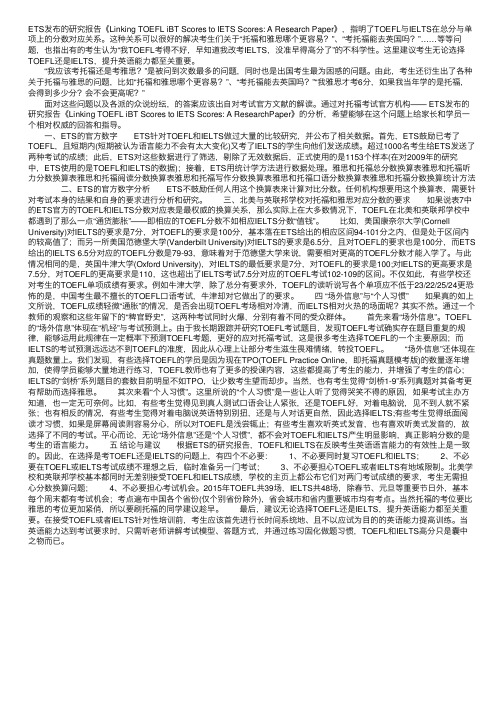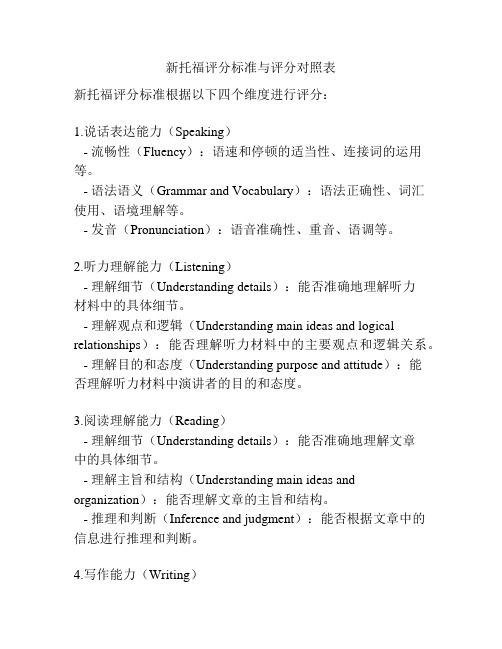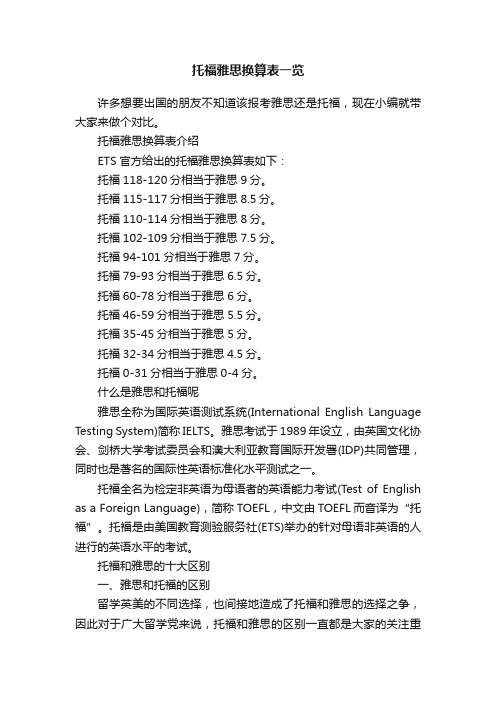托福考试分数换算表
托福分数官方换算表

ETS发布的研究报告《Linking TOEFL iBT Scores to IETS Scores: A Research Paper》,指明了TOEFL与IELTS在总分与单项上的分数对应关系。
这种关系可以很好的解决考⽣们关于“托福和雅思哪个更容易?”、“考托福能去英国吗?”……等等问题,也指出有的考⽣认为“我TOEFL考得不好,早知道我改考IELTS,没准早得⾼分了”的不科学性。
这⾥建议考⽣⽆论选择TOEFL还是IELTS,提升英语能⼒都⾄关重要。
“我应该考托福还是考雅思?”是被问到次数最多的问题,同时也是出国考⽣最为困惑的问题。
由此,考⽣还衍⽣出了各种关于托福与雅思的问题,⽐如“托福和雅思哪个更容易?”、“考托福能去英国吗?”“我雅思才考6分,如果我当年学的是托福,会得到多少分?会不会更⾼呢?” ⾯对这些问题以及各派的众说纷纭,的答案应该出⾃对考试官⽅⽂献的解读。
通过对托福考试官⽅机构—— ETS发布的研究报告《Linking TOEFL iBT Scores to IETS Scores: A ResearchPaper》的分析,希望能够在这个问题上给家长和学员⼀个相对权威的回答和指导。
⼀、ETS的官⽅数字 ETS针对TOEFL和IELTS做过⼤量的⽐较研究,并公布了相关数据。
⾸先,ETS⿎励已考了TOEFL,且短期内(短期被认为语⾔能⼒不会有太⼤变化)⼜考了IELTS的学⽣向他们发送成绩。
超过1000名考⽣给ETS发送了两种考试的成绩;此后,ETS对这些数据进⾏了筛选,剔除了⽆效数据后,正式使⽤的是1153个样本(在对2009年的研究中,ETS使⽤的是TOEFL和IELTS的数据);接着,ETS⽤统计学⽅法进⾏数据处理。
雅思和托福总分数换算表雅思和托福听⼒分数换算表雅思和托福阅读分数换算表雅思和托福写作分数换算表雅思和托福⼝语分数换算表雅思和托福分数换算统计⽅法 ⼆、ETS的官⽅数字分析 ETS不⿎励任何⼈⽤这个换算表来计算对⽐分数。
托福阅读分数换算表及阅读常考题型总结

托福阅读分数换算表及阅读常考题型总结托福小白可能对于托福考试的评分有很多疑问,比如阅读的题量和分数是如何换算的?阅读每篇14道题,一共考3篇,如果遇到加试,可能会考4-5篇阅读,加试题目不计入总分。
跟小编一起来看看托福阅读分数换算表和托福阅读常考的题型托福阅读分数换算表及阅读常考题型总结一.托福阅读分数换算表除重要观点题和归类题以外,每道题的分值都是1分,重要观点题的分值可能是2分,归类题为3或4分,考试所得分数范围:0-30分。
大家在算出原始分数以后,将被转化为0-30分的最终分数。
以下是托福阅读评分标准中原始分数与最终分数的对照表:二.托福阅读常考题型托福阅读题型共分为10种:1. Factual Information questions(事实信息题)2. Negative Factual Information questions(否定事实信息题)3. Inference questions(推论题)4. Rhetorical Purpose questions(修辞目的题)5. Vocabulary questions(词汇题)6. Reference questions(指代题)7. Sentence Simplification questions(句子简化题)8. Insert Text question(句子插入题)9. Prose Summary(文章总结题)10. Fill in a Table(表格填写题)托福阅读TPO30第3篇:The Invention of the Mechanical Clock 【1】In Europe, before the introduction of the mechanical clock, people told time by sun (using, for example, shadow sticks or sun dials) and water clocks. Sun clocks worked, of course, only on clear days; water clocks misbehaved when the temperature fell toward freezing, to say nothing of long-run drift as the result of sedimentation and clogging. Both these devices worked well in sunny climates; but in northern Europe the sun may be hidden by clouds for weeks at a time, while temperatures vary not only seasonally but from day to night.【2】Medieval Europe gave new importance to reliable time. The Catholic Church had its seven daily prayers, one of which was at night, requiring an alarm arrangement to waken monks before dawn. And then the new cities and towns, squeezed by their walls, had to know and order time in order to organize collective activity and ration space. They set a time to go to sleep. All this was compatible with older devices so long as there was only one authoritative timekeeper; but with urban growth and the multiplication of time signals, discrepancy brought discord and strife. Society needed a more dependable instrument of time measurement and found it in the mechanical clock.【3】We do not know who invented this machine, or where.It seems to have appeared in Italy and England (perhaps simultaneous invention) between 1275 and 1300. Once known, it spread rapidly, driving out water clocks but not solar dials, which were needed to check the new machines against the timekeeper of last resort. These early versions were rudimentary, inaccurate, and prone to breakdown.【4】Ironically, the new machine tended to undermine Catholic Church authority. Although church ritual had sustained an interest in timekeeping throughout the centuries of urban collapse that followed the fall of Rome, church time was nature’s time. Day and night were divided into the same number of parts, so that except at the equinoxes, days and night hours were unequal; and then of course the length of these hours varied with the seasons. But the mechanical clock kept equal hours, and this implied a new time reckoning. The Catholic Church resisted, not coming over to the new hours for about a century. From the start, however, the towns and cities took equal hours as their standard, and the public clocks installed in town halls and market squares became the very symbol of a new, secular municipal authority. Every town wanted one; conquerors seized them as especially precious spoils of war; tourists came to see and hear these machines the way they made pilgrimages to sacred relics.【5】The clock was the greatest achievement of medieval mechanical ingenuity. Its general accuracy could be checked against easily observed phenomena, like the rising and setting of the sun. The result was relentless pressure to improve technique and design. At every stage, clockmakers led the way to accuracy and precision; they became masters of miniaturization, detectors and correctors of error, searchers for new and better. They werethus the pioneers of mechanical engineering and served as examples and teachers to other branches of engineering.【6】The clock brought order and control, both collective and personal. Its public display and private possession laid the basis for temporal autonomy: people could now coordinate comings and goings without dictation from above. The clock provided the punctuation marks for group activity, while enabling individuals to order their own work (and that of others) so as to enhance productivity. Indeed, the very notion of productivity is a by-product of the clock: once one can relate performance to uniform time units, work is never the same. One moves from the task-oriented time consciousness of the peasant (working on job after another, as time and light permit) and the time-filling busyness of the domestic servant (who always had something to do) to an effort to maximize product per unit of time.托福阅读TPO30试题第3篇:The Invention of the Mechanical Clock1.Why does the author provide the information that "in northern Europe the sun may be hidden by clouds for weeks at a time, while temperatures vary not only seasonally but from day to night"?A.To emphasize the variety of environments in which people used sun and water clocks to tell time.B.To illustrate the disadvantage of sun and water clocks.C.To provide an example of an area where water clocks have an advantage over sun clocks.D.To counter the claim that sun and water clocks were used all over Europe.2.According to paragraph 2, all of the following are examplesof the importance of timekeeping to medieval European society EXCEPTA.the need of different towns to coordinate timekeeping with each other.B.the setting of specific times for the opening and closing of markets.C.the setting of specific time for the start and finish of the working day.D.the regulation of the performance of daily church rituals.3.According to paragraph 2, why did the medieval church need an alarm arrangement?A.The alarm warned the monks of discord or strife in the town.B.The church was responsible for regulating working hours and market hours.C.The alarm was needed in case fires were not put out each night.D.One of the church's daily rituals occurred during the night.4.The word "authoritative" in the passage(paragraph 2)is closest in meaning toA.actual.B.important.C.official.D.effective.5.The author uses the phrase "the timekeeper of last resort" to refer toA.water clocks.B.the sun.C.mechanical clocks.D.the church.6.The word "rudimentary" in the passage(paragraph 3)is closest in meaning toA.rare.B.small.C.impractical.D.basic.7.According to paragraph 4, how did the Catholic Church react to the introduction of mechanical clocks?A.Its used mechanical clocks through the period of urban collapse.B.It used clocks to better understand natural phenomena, like equinoxes.C.It tried to preserve its own method of keeping time, which was different from mechanical-clock time.D.It used mechanical clocks to challenge secular, town authorities.8.The word "installed" in the passage(paragraph 4)is closest in meaning toA.required.B.expected by the majority of people.C.standardized.D.put in place.9.It can be inferred from paragraph 5 that medieval clockmakersA.were able to continually make improvements in the accuracy of mechanical clocks.B.were sometimes not well respected by other engineers.C.sometimes made claims about the accuracy of mechanical clocks that were not true.D.rarely shared their expertise with other engineers.10.Paragraph 5 answers which of the following questions about mechanical clocks.A.How did early mechanical clocks work?B.Why did the design of mechanical clocks affect engineering in general?C.How were mechanical clocks made?D.What influenced the design of the first mechanical clock?11.The word "pioneers" in the passage isclosest in meaning toA.leaders.B.opponents.C.employers.D.guardians.12.According to paragraph 6, how did the mechanical clock affect labor?A.It encouraged workers to do more time-filling busywork.B.It enabled workers to be more task oriented.C.It pushed workers to work more hours every day.D.It led to a focus on productivity.13. Look at the four squares[■] that indicate where the following sentence can be added to the passage. Where would the sentence best fit? The division of time no longer reflected the organization of religious ritual.Ironically, the new machine tended to undermine Catholic Church authority. Although church ritual had sustained an interest in timekeeping throughout the centuries of urban collapse that followed the fall of Rome,church time was nature's time.■【A】Day and night were divided into the same number of parts, so that except at the equinoxes, days and night hours were unequal;and then of course the length of these hours varied withthe seasons.■【B】But the mechanical clock kept equal hours, and this implied a new time reckoning.■【C】The Catholic Church resisted, not coming over to the new hours for about acentury.■【D】From the start, however, the towns and cities took equal hours as their standard, and the public clocks installed in town halls and market squares became the very symbol of a new, secular municipal authority. Every town wanted one; conquerors seized them as especially precious spoils of war;tourists came to see and hear these machines the way they made pilgrimages to sacred relics.14. Directions: An introductory sentence for a brief summary of the passage is provided below. Complete the summary by selecting the THREE answer choices that express the most important ideas in the passage. Some sentences do not belong in the summary because they express ideas that are not presented in the passage or are minor ideas in the passage. This question is worth 2 points.The introduction of the mechanical clock caused important changes to the society of medieval Europe.A.The increasing complexity of social and economic activity in medieval Europe led to the need for a more dependable means of keeping time than sun and water clocks provided.B.Because they were unreliable even in sunny climates, sun clocks and water clocks were rarely used in Europe, even before the invention of the mechanical clock.C.Before the mechanical clock, every city wanted a large number of timekeepers because more timekeepers allowed for better organization of collective activities.D.Soon after the invention of mechanical clocks, sun and water clocks became obsolete because mechanical clocks werefar more accurate.E.Predators help maintain biological diversity by limiting populations of a dominant competitor species, thereby preventing that species from excluding others.F.The removal of sea stars reduces the diversity of the community in which they are predators, and is therefore a bad idea.托福阅读TPO30答案第3篇:The Invention of the Mechanical Clock1.从第一段的第二句开始,原文列举了这两种device各种的缺点,最后一句前半句说它们work,后面but表转折,证明要说有些情况它们不能用。
新托福评分标准与评分对照表

新托福评分标准与评分对照表新托福评分标准根据以下四个维度进行评分:1.说话表达能力(Speaking)- 流畅性(Fluency):语速和停顿的适当性、连接词的运用等。
- 语法语义(Grammar and Vocabulary):语法正确性、词汇使用、语境理解等。
- 发音(Pronunciation):语音准确性、重音、语调等。
2.听力理解能力(Listening)- 理解细节(Understanding details):能否准确地理解听力材料中的具体细节。
- 理解观点和逻辑(Understanding main ideas and logical relationships):能否理解听力材料中的主要观点和逻辑关系。
- 理解目的和态度(Understanding purpose and attitude):能否理解听力材料中演讲者的目的和态度。
3.阅读理解能力(Reading)- 理解细节(Understanding details):能否准确地理解文章中的具体细节。
- 理解主旨和结构(Understanding main ideas and organization):能否理解文章的主旨和结构。
- 推理和判断(Inference and judgment):能否根据文章中的信息进行推理和判断。
4.写作能力(Writing)- 内容与关联(Content and coherence):能否合理地组织和表达观点,并与给定的话题和任务相关联。
- 逻辑发展(Organization and development):能否使用适当的句子结构和段落结构,展开和发展论点。
- 语法语义(Grammar and vocabulary):语法正确性、词汇使用、语境理解等。
- 发音与拼写(Pronunciation and spelling):语音准确性、拼写正确性等。
评分对照表如下(以满分30分为例):- 26-30分:能流利、精确地表达自己的观点,语法语义准确,发音清晰。
雅思和托福分数换算

雅思和托福分数换算
来源:留学服务中心
ETS 发布雅思和托福分数换算表的主要目的是帮助申请人更好的对比这两种考试的成绩,以便于申请工作展开。
这个换算表所用到的数据是在同时参加雅思和托福考试的1153位考生的分数上分析得来的。
1、雅思和托福总分数换算表:
注意: Indicates score comparison ranges with the highest degree of confidence.
2、雅思和托福听力分数换算表:
3、雅思和托福阅读分数换算表:
4、雅思和托福写作分数换算表:
5、雅思和托福口语分数换算表:
6、雅思和托福分数换算统计方法:
以上就是全部雅思和托福分数换算表的全部内容,包括了总分数和各个单项分数的换算。
大家如果有需要可以适当的参考一下,以方便自己选择更加有利的考试方式。
gmat gre ielts toefl 对照表

以下是GMAT、GRE、IELTS 和TOEFL 的对照表,用于衡量英语能力和大学研究生入学考试成绩:
GMAT(Graduate Management Admission Test):
- GMAT 总分介于200-800之间
GRE(Graduate Record Examination):
- GRE 总分介于130-170之间(Verbal Reasoning 和Quantitative Reasoning 分数),还有一个Analytical Writing 分数在0-6之间
IELTS(International English Language Testing System):
- IELTS 总分介于0-9分之间,有四个模块:Listening(听力),Reading(阅读),Writing(写作),Speaking(口语)
TOEFL(Test of English as a Foreign Language):
- TOEFL 总分介于0-120分之间,有四个部分:Listening(听力),Reading(阅读),Writing(写作),Speaking(口语)
尽管这些考试都是用于衡量英语能力和在学术环境中的表现,但它们的评判标准和目的不尽相同。
具体要求和接受学校对于这些考试分数的要求可能会有所不同,建议您查看相
关学校或机构的官方要求来确定具体的分数要求。
托福口语分数换算表

托福口语分数换算表——你的口语分数是怎么算出来的?托福口语和作文均是托福考试中的主观判分的项目。
“Good”、“Fair”、“Limited”、“Weak”四个档次与我们最终的口语分数究竟有什么样的关系呢?今天狮子来为大家分析一下这中间的过程,希望大家看完之后能了解自己的口语分数是如何计算出来的。
一般考生考完试之后,答案以及录音均会提交至ETS进行下一步的打分和评判。
其中口语这一部分的录音将会经历以下过程:1. 每道口语题会被一位考官给一个原始分(0-4 之间的整数分)。
2. 一个考生的六道口语题,至少会被三个不同的考官评分。
3. 六道口语题的分数加在一起(0-24分),取算数平均值(0-4分之间,但会出现小数点后0/.83/.66/.50/.33/.16 六种不同情况)4. 该平均值,根据下面这张转换表,转换为0-30分的总分。
Speaking RubricScaled ScoreMean Average4303.83293.66283.5273.3326 3.1624 323 2.8322 2.6620 2.519 2.3318 2.1617 215 1.83141.6613 1.511 1.3310 1.169 18 0.836 0.665 0.54 0.333 0.162 01其中,大家的成绩单上还会根据不同题型,按照Familiar Topics,Campus Situations,Academic Course Content三个部分对大家进行评价,均是通过每道题目的分数,根据算术平均数的计算结果,结果分为4个标准,每个标准对应的分数如下:Good:3.5-4.0Fair:2.5-3.0Limited:1.5-2.0Weak:0-1.0根据以上对应关系和转换表,我们大致可以推算出以下结果:以上就是托福口语分数出炉的全过程了,大家可以参考上面的图表验证一下。
这个区间对于考生的参考意义在于,同一区间下的分数复议改变的可能性较大。
托福雅思换算表

托福雅思换算表托福雅思换算表 (3000字)在全球范围内,托福和雅思是最受欢迎的英语语言考试。
这两个考试都是为了评估非英语母语的人士的英语语言能力。
虽然这两个考试的目标相同,但它们的评分系统和分数换算并不相同。
本文将介绍托福和雅思之间的换算表,以帮助考生更好地理解两个考试之间的对应关系。
首先,我们需要了解托福和雅思的评分系统。
托福考试分为四个部分:听力、阅读、口语和写作,每个部分的最高分为30分。
而雅思考试分为四个部分:听力、阅读、写作和口语,每个部分的最高分为9分。
所以我们需要一种方式来将这些分数互相换算。
以下是托福和雅思分数之间的换算表:托福总分雅思总分110-120 9102-109 8.594-101 887-93 7.580-86 773-79 6.560-72 642-59 5.535-41 532-34 4.510-19 3.50-9 3需要注意的是,这只是一个大致的换算表,考生的具体分数与对应的雅思分数可能会有所不同。
此外,托福和雅思两个考试的难度和题型也有所不同,所以换算只是一个大概的参考。
除了总分之外,考生还可以比较各个部分的得分。
以下是托福和雅思各部分的换算表:托福听力雅思听力22-30 919-21 8.515-18 812-14 7.59-11 76-8 6.54-5 63 5.52 51 4.50 0托福阅读雅思阅读27-30 924-26 8.519-23 815-18 7.513-14 77-9 64-6 5.53 52 4.51 40 0托福口语雅思口语24-30 922-23 8.518-21 816-17 7.514-15 712-13 6.510-11 68-9 5.56-7 54-5 4.50-3 0托福写作雅思写作24-30 922-23 8.518-21 816-17 7.514-15 712-13 6.510-11 68-9 5.56-7 54-5 4.50-3 0需要注意的是,托福和雅思的口语和写作部分的换算相对较为粗略,因为考试的形式和评分标准并不完全一致。
托福雅思换算表一览

托福雅思换算表一览许多想要出国的朋友不知道该报考雅思还是托福,现在小编就带大家来做个对比。
托福雅思换算表介绍ETS官方给出的托福雅思换算表如下:托福118-120分相当于雅思9分。
托福115-117分相当于雅思8.5分。
托福110-114分相当于雅思8分。
托福102-109分相当于雅思7.5分。
托福94-101分相当于雅思7分。
托福79-93分相当于雅思6.5分。
托福60-78分相当于雅思6分。
托福46-59分相当于雅思5.5分。
托福35-45分相当于雅思5分。
托福32-34分相当于雅思4.5分。
托福0-31分相当于雅思0-4分。
什么是雅思和托福呢雅思全称为国际英语测试系统(International English Language Testing System)简称IELTS。
雅思考试于1989年设立,由英国文化协会、剑桥大学考试委员会和澳大利亚教育国际开发署(IDP)共同管理,同时也是著名的国际性英语标准化水平测试之一。
托福全名为检定非英语为母语者的英语能力考试(Test of English as a Foreign Language),简称TOEFL,中文由TOEFL而音译为“托福”。
托福是由美国教育测验服务社(ETS)举办的针对母语非英语的人进行的英语水平的考试。
托福和雅思的十大区别一、雅思和托福的区别留学英美的不同选择,也间接地造成了托福和雅思的选择之争,因此对于广大留学党来说,托福和雅思的区别一直都是大家的关注重点。
今天我们就来看看除了,托福和雅思的区别费用之外,雅思和托福的区别有哪些?1. 出题机构(1)相异点:雅思(International English Language T esting System,简称IELTS)是由英国文化委员会(The British Council)、剑桥大学地方考试委员会(CUCLES)和澳大利亚教育国际开发署(IDP Education Australia)三大国际性机构联手举办的国际英语水平测试。
托福和雅思成绩换算表官方出炉

托福和雅思成绩换算表官方出炉大家想不想知道雅思托福的分数怎么换算,下面小编给你分享一个换算表,仅供参考!雅思托福分数换算表一览近期,ETS官网上发布了一个有趣的托福和雅思的分数换算表,这个换算非常的有趣,可以让托福的考生知道如果自己考雅思能考多少分,相当于他把托福和雅思的分数进行了换算,让两个本来没有直接关系的考试项目变得互通了,真的是非常的有意思,接下来大家一起来看看换算表吧。
(PS: 数据基于1153位同时考过TOEFL和IELTS学术类考试的考生成绩)一、托福和雅思成绩换算总表:二、托福和雅思阅读成绩换算表:三、托福和雅思听力成绩换算表:四、托福和雅思口语成绩换算表:五、托福和雅思写作成绩换算表:六、ETS官网工具一览:大家看了以后是不是也觉得很有趣呢,没想到ETS官网还弄出个这么好玩的换算表,好啦,不管怎么样,最重要的还是在考试中获得高分,如果说你也想获得雅思或者托福的高分,不妨来新航道来学习吧,我们这里教出过很多托福和雅思的学霸,来我们这里不仅有名师教导,还可以和学霸们一起交流哦。
托福备考-攻克托福词汇、口语两大难关难题一:词汇对新托福有所了解的同学一定知道,托福考试的词汇量要求是8000到1万个词。
所谓工欲善其事,必先利其器。
那么托福考试的“器”理所当然就是我们的词汇了。
对于广大中国考生而言,考英语始终有两大难题困扰着大家:一、词汇量,二、口语。
参加新托福考试的考生大多数是高中学生,我们知道,根据现在我国高考大纲的规定,高中毕业生的词汇量一般是在3500个词左右,这与托福的要求差距是显而易见的。
所以词汇是我们在托福考试中遇到的第一个难题。
1、背词汇那么要如何解决词汇量的问题呢?首先可以从背高考词汇开始,然后是4级的单词,进而逐渐过渡到托福。
这对于大家的记忆力和毅力是一种考验。
只要一说到背单词,许多同学动辄就说,现在记忆力不行了,说自己小学初中记忆力如何好。
其实不然,大家只是在找理由。
托福口语怎么算分的

托福口语怎么算分的01.分数是按档位来算的你知道吗?TOFEL Speaking的每道题目其实满分只有4分!分数的算法是这样的:大家考完试以后,录音会提交到ETS,考官们为考生的每个答案打分,每道题的满分均为4分。
之后,依据题型的不同计算每个题型的均分,换算成相应的档位,最后依据档位换算成大家最后的口语分数。
具体换算标准请看下表。
读表Tips:横向看换算表。
口语一共考6道题目,分为三项, 1,2题算一项,3,5算题一项, 4,6题算一项。
每一项的评分有4个档位,最后依据档位换算成对应的分数比如,如果拿到3个good, 则可得2730分02.档位的评价标准有哪些了解了分数是怎么换算的以后,我们该怎么拿到Good呢?托福口语从四个方面打分1. 构思:是否扣题;逻辑关系是否清楚2. 拓展:拓展的内容不是主题句的重复,且要紧口主题句,论据的内容有说服力(切忌假大空)3. 表达:发音,连贯,语速4. 语言使用:语法,词汇准确;句型多样化;不死套模板03.怎么回答才干有高分其实TOFEL口语的大部分题目回答时都是有相应的结构的,*得分的要点就是:不管你要怎么复述转换原文,都要按结构来清楚的答题。
2托福口语备考须做的三件事托福口语准备工作的核心是积存素材和锻炼思维速度。
这也是托福口语必备的基础,是决定你的托福口语的流利程度和语言优美程度的关键,当然也是你拿托福口语高分的关键。
1、参加托福口语考试以前,多读些好文章,建议读写作范文,这样,等同于把写作口语全部都准备了。
多读,记些好句子,将好的词与句都放好,当考试时用属于托福口语一定要具备的东西。
2、当发现自己才有一些感觉了,如此将托福口语的综合教材拿出来,将有的学习做一下,可以帮助发散思维。
碰到题目后,可以快速的把思维展开,列出基本条目,会给你很大的优势。
3、在这些都做好了,再去观察一下自己教材里的范例回答。
参照一下即可。
不要死记硬背。
必须要把自己想要的知识点发展出来。
托福改革后听力评分标准表

托福改革后听力评分标准表
托福改革后的听力评分标准如下:
1.原始分:每道单选题得1分。
答对2个多选题得2分,答对1个得1分,答对0个得0分。
5选3多选题,答对3个得2分,答对2个得1分,答对1个及以下得0分。
表格题,全部答对得2分,之后错一个减1分,最少0分。
2.托福听力的标准分(scale score):这是在托福成绩单上看到的分数。
原始分的最大问题是,由于不同考试的难度不同无法让不同考试的结果互相比较。
因此,标准分是用于解决原始分无法比较的问题。
在新的算分标准下,听力题目减少,容错率也相应的有所提高,对高分段同学而言,更容易拿高分。
听力满分容错率高达3题,遇到的试卷难度不同,错0-3题都可以拿到托福满分。
以上信息仅供参考。
